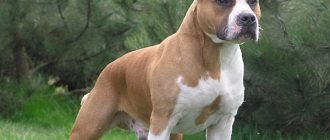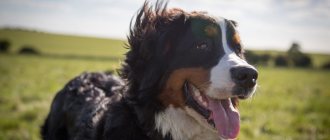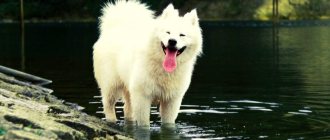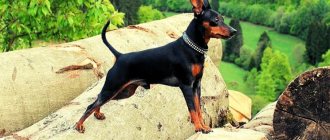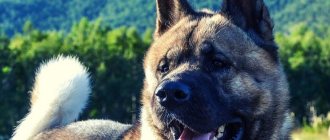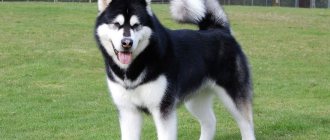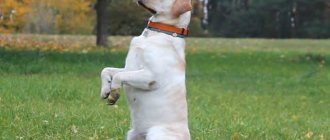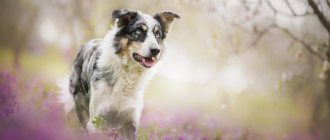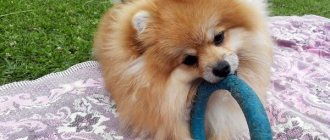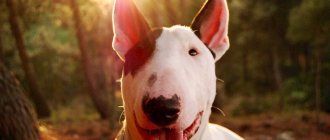When purchasing a four-legged pet, owners often focus not only on their external characteristics, but also on what the dogs themselves can do. In this regard, Staffords are very talented. They can serve as guides, rescuers and search engines. But most importantly, these are devoted friends who love their owners, adore children and are ready to rush to their defense at any time. Stafford puppies are unusually active and cheerful, so the pet immediately wins the love of all family members.
Stafford puppy
Staffordshire Terrier: training, educational features
The American Staffordshire Terrier is a strong, muscular dog that has an excellent sense of danger and loves people, so with proper training it can make an excellent bodyguard. Proper upbringing of an Amstaff by a loving owner allows you to raise a puppy of this breed into a kind, affectionate, family dog that gets along well even with small children. Raising young animals at home is constant work aimed at consolidating acquired knowledge and developing a reflex response to the owner’s command.
Features of raising puppies in the first year of life
An Amstaff puppy under the age of one year does not need to be trained, but raised. And if you treat this with a certain degree of negligence, it can grow into a dangerous, aggressive creature, despite the genetically inherent love for a person. To raise a responsive, friendly dog, you should not ignore the slightest hint of aggression, even in a tiny puppy. Otherwise, it is unlikely that in the further process of education a Staffordshire Terrier will grow up to be socially safe for surrounding people and animals.
It is important to clearly understand that in the first year of life a Staffordshire cat needs education, patience and love. There will still be time for training, but if you miss the age at which you need to explain to the Amstaff how to behave in the house, on the street, in communication with people and other animals, problems will be guaranteed. Such a dog can only be walked with on a leash, away from society, and this will interfere with its harmonious psychological, intellectual and physical development.
At about the age of 7-8 months, Staffordshires have a clearly visible temperament. Amstaffs come in two character types: aggressive people who like to fight and sweet, good-natured people who do not tolerate squabbles. The entire training system should be based on this. It all depends on what goal the owner sets for himself, and who he wants to get in the end: a fighter or a defender.
Training a Staffordshire Terrier is a process whose goal is to develop certain skills and abilities that can be used to control the behavior of the animal.
In addition, training a Stafford has its own characteristics, so it is better to start training when the puppy reaches the age of 4 months. During this period, the puppy has the necessary physical data to carry out commands.
Training should be based on such types of exercises, the purpose of which is to achieve and polish the necessary reflexes in the dog. Therefore, the animal owner needs to clearly understand what he wants from his pet in order to structure training in the right way. Training at home is basic and the knowledge gained from the owner of the house will serve as an excellent foundation for special training.
As soon as the dog reaches the age of 7 months, it can be trained in special dog training areas. Contrary to public opinion, Staffordshire Terriers are very intelligent and perfectly understand and perform the assigned task, therefore, if you approach training wisely and responsibly, difficulties should not arise.
BARF system for staff
The BARF diet is based on foods that Staffies would presumably eat in the wild. It includes:
- raw meat;
- various bird bones, except rib and tubular bones, soft lamb bones;
- offal;
- sea fish;
- raw vegetables, herbs, berries and fruits;
- dairy products;
- eggs.
In addition, various vegetable oils, fish oil, vitamins, and bran are added to the staff’s diet. Owners and staff of veterinary clinics note the huge advantage of such nutrition for dogs of any kind.
How and what to feed your pet is always decided by the owner himself. It is important that this is a complete diet that will not cause allergies, so this issue must be approached responsibly.
If you got a Staffordshire Terrier, then along with parting with free time, try to say goodbye to one of the common stereotypes. Many people believe that dogs need to be fed bones and that a piece of raw meat is enough to keep them full all day. This is not entirely true: the nutrition of any dog should depend on its physiological characteristics, health status, weight, height and many other things.
If you choose this dog, then a faithful friend will settle in your home for many years. This friend is one of the largest dogs with a high activity level and a lifestyle that needs to be maintained every day.
What should you teach your puppy first?
The age of two to six months is considered the most effective in training the American Staffordshire Terrier. It is important not to neglect the puppy’s upbringing, otherwise it will be impossible to get rid of bad behavior, and instead of joy, the pet will bring a series of sorrows to the owner.
How to raise a Staffordshire Terrier, the main nuances:
- Train your dog to relieve itself only outside. Amstaff needs to be taught cleanliness. To teach a puppy to use the toilet outside, you need to walk him as much as possible. It is recommended to take him for a walk after every meal. After he has recovered from his natural needs, he must be praised and rewarded with a treat. Under no circumstances should you scold, much less physically punish, if your pet goes to the toilet on the floor of the house or apartment. The correct parenting option would be to increase the frequency and duration of walks.
- It is necessary to explain to the dog that furniture and floor coverings should not be damaged. An Amstaff puppy should not be left alone for a long time. This is a social and sociable dog, so the pet will be bored and guaranteed to chew on everything. To prevent this from happening, it is necessary to establish the closest possible contact between the staff and the person, play with him more, take walks, show kindness and patience. It is important to understand that all conditioned habits are fixed in puppyhood, and if this is not done in time, in the future the Amstaff will show willfulness. Of course, it is impossible not to punish at all. The main thing is that it is on time and not painful, and the puppy is not afraid. For example, shake him by the withers, catch him in the act of damaging the furniture, and say in a menacing voice “you can’t!” so that the baby understands that he is being scolded and for what he was punished.
- Stop biting your fingers and toes while playing. For a young pet, biting is natural as his teeth grow and his gums itch. However, if you do not teach him to behave this way before the age of six months, he will develop a clear understanding that this is normal, and in the future, difficulties may arise when training an already grown dog. Beginning dog lovers are often interested in methods for teaching a puppy not to bite. Experienced Staffordshire Terrier lovers advise throwing a toy or ball to the pet so that it has the opportunity to scratch its teeth. This should be done as often as possible, periodically praising the amstaff. Gradually, he will develop the habit of playing with the ball, and not with the heels of the owner. If the baby continues to bite, you can pretend to be offended by saying “it hurts!” and press him to the floor. You need to wait until the naughty cat calms down and transfer him to his bedding by the scruff of the neck. This way the amstaff will understand that if he continues to bite, they will no longer play with him.
Staffs love praise very much. Therefore, when adjusting behavior, it is important to frequently reward the pet, and he will try to behave in such a way that the owner is satisfied.
Dog handlers believe that raising a Staffordshire Terrier should be done with carrots and sticks, then the effectiveness will be higher. At the same time, the Amstaff should perceive the owner as a kind, but demanding friend.
Subtleties of amstaff training
Where to start and how to train a Staffordshire Terrier:
- Gradually wean him off the leash. The Amstaff must be able to hear and follow the trainer's commands without being pulled back. To do this, you need to walk your dog more often and when you reach the park area, let it off the leash and start running. In the process, he must learn the command “near!” You need to start training at 3.5-4 months, before he becomes dangerous and uncontrollable.
- The next important point in training a Staffordshire Terrier is the ability to behave in society without showing aggression towards other dogs. He must understand that he cannot fight with other dogs. To do this, you need to take your pet’s favorite toys for a walk in order to distract his attention in case of aggression, as well as a treat to encourage him.
- Young staffs are very active and often uncontrollable. Classes with your pet should be structured so that the pet understands who is in charge and recognizes the person’s leadership.
Feeding scheme with natural products
The nutrition of an adult dog should be tailored to its characteristics and activity. The staff's food portions need to be increased if he is undergoing training or needs to gain weight. You can calculate the daily volume using the formula:
- up to 6 months - 6-7% of body weight;
- after 6 months - 3-3.5% of the pet’s weight.
For example, for a pet older than 6 months and weighing 15 kg, you will need 600 g of food. One half should consist of fermented milk products, kefir, cottage cheese, and the second half (300 g) of raw meat. Raw vegetables and vegetable oil should not be included in the formula.
The appearance of a pet in the house
If there is a small child in the family, you don’t have to worry, because the Amstaff’s behavior with children is distinguished by caution and understanding.
The dog knows very well that the child is much weaker and will succumb to the baby; it gets along well not only with children, but also with other pets.
Owners can recognize health problems by the following signs:
- Amstaff's nose is warm and completely dry, the pupils of the eyes are dull;
- poor sleep and loss of appetite;
- unpresentable appearance of dog hair, loss of shine;
- frequent urge to urinate, even breathing and wet mucous membranes.
American Staffordshire Terrier puppies need care and proper grooming. To prevent your dog from getting sick, you need to bathe it on time, walk it, and brush its teeth, ears and nose.
If you are thinking about buying a puppy of this breed, you need to know what types of terriers are available and what are their differences.
Nutrition for an adult dog
Owners have several options on what to feed their staff as it grows up. This is natural or dry food. In both cases, you can find advantages and disadvantages, so you need to focus on the well-being, activity, and appearance of the pet.
Dry food helps to avoid mistakes in the composition of the diet, the amount of servings and vitamin supplements. This type of food guarantees sanitary quality and does not require special storage measures. The disadvantages include the fact that Amstaffs do not always like this diet, and digestive complications are also possible.
Important! For the Staffordshire Terrier, food for medium dogs is suitable.
Natural food provides variety in the diet and can be formulated based on your pet’s preferences. However, it is difficult to make such a diet balanced, so there is a risk that the pet will lack important elements.
Breed varieties
Show-class staff belong to high-breed dogs and have clearly defined qualities described in the breed standard.
This puppy is worth buying if you are serious about preparing for exhibitions, competitions, or want to open a kennel of American Staffordshire Terriers.
Breeding class - such dogs are also called breeding dogs, these are typical representatives of the Amstafa breed, which do not have strong deviations from the breed standard, and are suitable for exhibition and breeding.
Pet class. Such a pet may have defects. This could be an asymmetrical skull, dental irregularities, an unusual color for a Staffordshire Terrier, or an atypical tail shape.
Such defects do not have negative consequences for the health of puppies, but they are not suitable for breeding.
What is the BARF system
Some owners feed their dogs according to the BARF system, which involves nutrition as close as possible to the diet of wild animals. The acronym BARF stands for Biologically Appropriate Raw Food and is meant to imitate the diet consumed by the wild ancestors of modern dogs.
The main menu of the animal in this case consists of unrefined and not thermally processed meat. If the owner decides to feed the pet different foods (meat, vegetables and cottage cheese), then they are all served at the same time. Food should not be cut into small pieces so that the dog can gnaw and chew them, thereby getting as close to natural conditions as possible.
The character of doggies and their upbringing
The Amstaff puppy looks like a chubby round puppy with a bare belly.
He is very active, enjoys chewing on slippers and loves to misbehave in the house in every possible way.
For this reason, from the first days of acquaintance, you need to educate him and accustom him to order.
To prevent your dog from dragging your socks, T-shirts and other items around the room, make sure you have a sufficient arsenal of toys. They should be made of a variety of materials.
There are whole myths and legends about the aggressive character traits of Staffordshire Terriers. It depends only on the owners how this pet will grow up.
If you abandon your dog and do not pay enough attention to its upbringing, the older dog may become angry and show aggression.
To achieve obedience and correct behavior from a four-legged animal, follow some rules.
The educational process should begin at the age of no later than 1.5-6 months. Even as a baby, a terrier must understand what behavior is acceptable and what is not.
Then you won’t have any difficulties when the dog grows up and his character develops.
Introduce your four-legged friend to the environment from the very first days, always praise for correctly executed commands and punish for misbehavior and incorrect behavior.
But you cannot punish a dog by shouting or using physical force.
Provide your pet with a well-chosen and balanced menu. You can consult your veterinarian on this issue.
The diet must contain water, dietary supplements, minerals and vitamins of groups A, B, C, D, E, K.
Staffordshire Bull Terrier puppies are smaller than American Staffordshire Terriers, but both breeds have bold personality traits.
Such dogs are good protectors and loyal friends for the whole family. With the right approach to education, a terrier is distinguished by its intellectual abilities and the ability to restrain emotions even under the most unexpected circumstances.
How to choose the best dry food for staff
Chronic diseases and allergies in dogs often appear due to improper nutrition. Dry food should contain:
- proteins - veal, beef, offal, poultry;
- carbohydrates - oatmeal, barley cereals;
- fiber - fruits, vegetables;
- fats - omega acids;
- antioxidants;
- vitamins, minerals.
High-quality feed contains more than 30% meat in its composition. Dry food easily solves the problem than feeding the Amstaff every day.
Note! Quite often, dog owners are faced with a problem when their pet refuses to eat any food, or it turns out that the dog is allergic. Therefore, it is not recommended to purchase feed for future use.
Care and maintenance
Many owners, due to their inexperience, begin to play the game “tug of war” with terrier puppies.
This game is very useful and interesting for pets, but at the age of up to 4 months, it can be dangerous for the baby.
The essence of the game is to take away a rope or piece of fabric from each other. For this activity, buy a rope at a specialty store.
Why might this be dangerous for the puppy? She may develop an incorrect bite, and when all the teeth are fully formed, she can play with a rope or string without fear.
When all the teeth are replaced with new ones, they need care. The dog is not able to provide the necessary care for its oral cavity on its own.
You will need dog toothpaste, which should be periodically applied to your puppy's teeth with your fingers or a brush.
Never use human toothpaste, it is very foamy and causes stomach upset in animals.
Staffordshire Terrier puppies must get used to a certain diet during childhood.
In the first months of life, they are fed up to 5-6 times a day, but in small portions so that the baby does not overeat.
If you find leftover food after eating, hide it until next time. Don't let your dog eat at random.
Your pet should have only water freely available at all times, because he spends a lot of energy reserves and strength on games and pampering.
How to choose the best dry food for staff
Review of dry food Acana Sport&Agility, Grandorf Lamb&Rice, NOW Natural Fish, GO! Fit
To choose the best dry food for your Staffordshire Terrier dog, you can:
- take advice from your puppy’s breeder;
- ask an experienced veterinarian for advice;
- Find the best food through trial and error.
The fact is that objectively there is no best food that will suit all puppies of a given breed. Naturally, there are many premium foods that contain many useful components and microelements, but you should always rely on your dog’s individuality.
To make it easier for you to navigate the world of dry food for your animal, we present you with an analysis of some foods that may be suitable:
Acana Sport&Agility
Grandorf Lamb&Rice
NOW Natural Fish
GO! Fit
Calorie content per kilogram of feed
How can you tell if the food is suitable for your dog?
Immediately after choosing food, it is impossible to conclude whether it suits the dog or not. You need to observe the animal for at least two to three months. It is important to strictly follow all recommendations for feeding, which are on the back of the package. Sometimes it happens that the dog vomits from food, or it stops being active. This happens when there is an excess of food in the body. Look at your pet after some time - if he is active, his coat is shiny and he eats with appetite, then we can conclude that you have found the food that your dog needs.
Buying and selling
Where is it generally customary to buy and sell these animals? First of all, we need to talk about nurseries.
By choosing an American Staffordshire Terrier kennel, you can find a healthy and beautiful dog of this breed.
But be prepared for the corresponding prices; check immediately how much a puppy costs in a particular nursery.
In such places, the best puppies of the litter are often kept, and the rest are offered for sale, and at an exorbitant price.
On the Internet you can find out how much such a puppy costs from private sellers. In this case, you need to try to protect yourself by asking the sellers to show not only the staff, but also his parents.
This method is good because it will be convenient to pick up the puppy in your city. But despite the prices, nurseries are safer places for such purchases.
If you decide to become a Stafford breeder yourself, know that it is troublesome, but can bring good income.
These puppies have always been appreciated, how much does a staff cost?
The price varies between 50-1000 dollars, depending on the pedigree, documents and place of purchase.
Once you get such a dog, you won’t want another one; the Stafford is a wonderful companion, a guard and just a funny dog!
What is prohibited from feeding a dog?
Experienced dog breeders know that staff loves selective food, but you can’t give it everything. The following products are prohibited:
- sweet;
- salty;
- roast;
- smoked meats;
- fatty foods;
- sausage, frankfurters, etc.;
- seasonings, spices;
- legumes;
- boiled potatoes;
- flour products;
- tubular bones.
Important! The dog should not be fed from the table, such treats cause metabolic disorders, lead to dental caries, and interfere with kidney function.
Photo gallery
Despite the widespread opinion about the aggressiveness of this breed, it should be said that with proper care and education, your pet will pleasantly surprise others with its friendliness and calmness.
In this video you will see how a three-month-old American Staffordshire Terrier puppy is taught to behave correctly on the street.
Caring for an American Staffordshire Terrier puppy
Finally, the puppy is chosen, and you, overwhelmed with joy, rush home.
If you purchased a puppy at the age of 1.5-2 months, then the main thing you should worry about is quarantine. An unvaccinated puppy is vulnerable to various diseases, so you should never take him for a walk, and at home you need to make sure he doesn’t pee on your outdoor shoes. It is better if the puppy has limited access to the part of the corridor where you take off your shoes. The first vaccination is given at 2 months, the second - at the discretion of the veterinarian, who must be licensed, is given after 2-3 weeks.
The dates of vaccination are recorded by the doctor in the veterinary passport. If you purchased a puppy that has already grown up (4-6 months), then you should be given a veterinary passport along with the main documents for the dog. Health issues, which include deworming and vaccination, as well as the quarantine accompanying these measures, are perhaps the most important, and they must be treated with full responsibility.
To have your puppy's ears cropped, you need to invite a veterinarian who has extensive experience working with Staffordshire dogs . The procedure for ear cropping is simple and, from a technical point of view, any surgeon can handle it, but only an experienced veterinarian can choose the appropriate ear shape for a particular dog, taking into account the type and shape of the head. The breed standard, as you know, gives preference to undocked ears, but still, from an aesthetic point of view, a Stafford's head with beautifully cropped ears looks great. For a happy life, your puppy needs a certain set of tools and accessories. First of all, it's a "place". A plastic bed, which can be bought at any pet store, is perfect for these purposes. You need to select it taking into account the size of an adult dog, the bed is very easy to wash, dogs like it because of the “nest” effect. If you put thick bedding inside, the puppy will feel cozy and protected.
The second important element is bowls. It is best to purchase stainless steel bowls on a special stand with a height adjuster. A puppy, just like an adult dog, should not eat from the floor. For the correct formation of the shoulder girdle and the stance of the forelimbs, the food bowl should be at the level of the puppy’s shoulder. As the dog grows - with the help of a height adjuster - the bowl rises. So, one bowl is for food, the second is for water, which, in turn, should always be in a place accessible to the puppy.
Dog care products include a rubber brush in the form of a hand mitten, with which it is very convenient to care for the short and fairly coarse hair of the Stafford. By regularly brushing your puppy, you not only give him a lot of pleasure with your attention, but also massage the puppy’s skin, thereby improving its blood supply, and comb out dead hair. Just like the brush, your puppy needs a special shampoo appropriate for his age. It’s always nice to look at a clean dog, and you need to wash it at least once a month, teaching it to this procedure from childhood.
Toys are absolutely necessary for a puppy. For the little Staffordshire, the eternal “discoverer,” toys must be durable. Like any other puppy, the little Staffie tries to test everything, but in our case we need to take into account that already in puppyhood the strength of the puppy’s jaws is quite strong, so toys made of latex, thin rubber, or soft toys are not suitable for the American Stafford. All this can be torn into small pieces and swallowed. The consequences can be unpredictable, even disastrous. Separately, it is necessary to say about the cage. Under no circumstances should you perceive a cage as a prison. It can and should be completely natural for a puppy to stay in it while no one is home. The cell is very disciplinarian. While you are away from home, you can be sure that the puppy has not chewed the wires or been electrocuted, has not swallowed any object left on the butt by your child, or, finally, chewed the sofa or ripped off the wallpaper. Cages of modern design are convenient, they fold up as needed and in this form take up very little space.
Food for older dogs
When do dogs become old?
Many dog handlers and veterinarians are of the opinion that a dog becomes elderly when it reaches the age limit of eight years. This age was taken abroad because the average life expectancy of a dog is 12-13 years.
Despite the established opinion of experts, you need to look at your pet’s behavior. If your dog is as cheerful and cheerful, has a shiny coat, and good bowel movements at eight years old as he did at four, then there is no need to radically change his diet. He needs the same amount of nutrients as he did before he was eight years old.
It happens that a dog develops shortness of breath and slowness even before the age of eight. In this case, you need to switch it to a lighter mode.
Basic nutrition rules for older Staff dogs
- For older Staffordshire Terrier dogs, a special diet is provided, which should contain a reduced amount of proteins, calories and fats, but an increased amount of carbohydrates. Proteins can be replaced with fish or dairy products. This method of feeding allows you to quickly feel full and consume fewer calories, which is beneficial for older dogs. But we should not forget that dogs do not digest carbohydrates well, so it is very important to choose the optimal set of grains and vegetables: one that will be well absorbed by a particular dog.
- It must be remembered that in old age dogs are prone to constipation, so wheat bran should be added to their diet to improve the bowel movement process.
- Often older dogs have dental problems, which makes it difficult for them to chew food as usual. If you feed your dog natural food, chop the pieces a little more thoroughly than usual.
- The diet of dogs in aging must take into account all the changes that occur with the pet. This includes general activity, weight, diseases, and joint condition.
